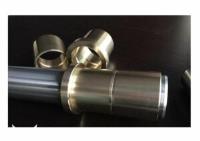 Add My Company
Add My Company
Sign In
Better results with a harder shaft
11-02-2022

This week we will be looking at why a bronze plain bearing is much more reliable with a hardened shaft than it is with a soft shaft. So, let’s get started.
Hardening Heat treatment involves heating the metal to a sufficiently high temperature to dissolve the impurities. Steel is usually heated up between 800°C and 900°C and then rapidly cooled down or ‘quenched’ for those who are technical minded, in either water or oil. The key advantage of hardening a shaft is that it enhances the durability of the metal. This means that the metal can withstand wear, pressure, damage, or fatigue. Meaning it has a longer life span. Now let’s talk about why you should use a bronze plain bearing with a hardened shaft. Having a bronze plain bearing on a hardened shaft can complement each other in many ways. The bronze plain bearing has a lower coefficient of friction with a hardened steel shaft than it would if the shaft was not hardened. Because the steel shaft is more resistant to corrosion, wear, and rough usage when it’s hardened, the bronze plain bearing will adjust to the smooth surface of the hardened shaft and will last considerably longer than a soft shaft where there will be a rough surface and damage that can chip away at the bronze plain bearing, leading to fractures and fatigue.
How many different types of hardness testing do you know? If you guessed three, then congratulations you are correct. That’s right there are 3 main types of hardness testing. Rockwell Hardness Test, Brinell Hardness Test and Vickers Hardness Test. Everyone has heard of the Rockwell Hardness Test; this is the most common form of testing the hardness of the metal. It is also the quickest and cheapest form of testing compared to the other two. Some might even say it’s faster than a blink of an eye. Obviously, it’s not but you can imagine just how fast it is. It requires almost no material preparation, and the hardness result is easily read without extra equipment. The second method is the Brinell Hardness Test. This was the first widely used test, and this method determines the indentation of the metal and is normally used for materials with a surface too rough to be tested by the Rockwell method or the Vickers method. However, the test is not useful for fully hardened metals and can leave a large impression on the surface of the metal. This is also the slowest test of the three. Therefore, they had to come up with new methods. And finally, there is the Vickers Hardness Test. This is the most accurate of the three and requires less force using a diamond-tipped indenter. However, it does require an optical system and a lot of material preparation, making the test a lot more expensive and taking much longer than the Rockwell test.
For more information on Better results with a harder shaft talk to Criptic-Arvis Ltd
Enquire Now
List your company on FindTheNeedle.

